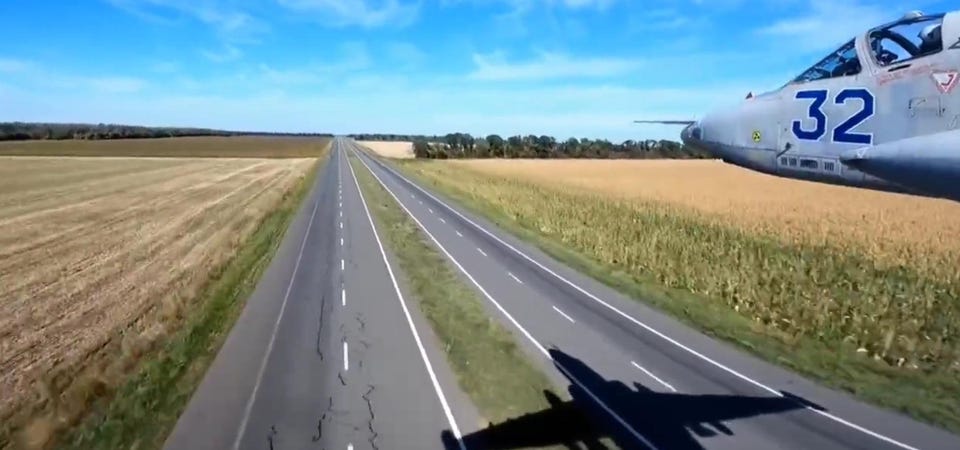Ukrainian troops are on the move —rolling along wide highways and across open fields as they counterattack in eastern and southern Ukraine. They’re out in the open in broad daylight. They should be easy targets for the Russian air force’s hundreds of modern fighter-bombers.
But the Russian air force is missing in action. It has made no meaningful effort to halt the twin Ukrainian counteroffensives that kicked off on Aug. 30 in the south and eight days later in the east.
It’s not hard to explain the Russian warplanes’ absence. Russia’s old-fashioned air-war doctrine can’t keep up with a fast-changing battlefield. And the Ukrainian army and air force, against all odds, still are mounting a stiff defense of the air space over the front lines.
Befuddled by the chaos on the ground and harried by Ukrainian missiles and guns, Russian pilots mostly are sitting out the current campaign. The Ukrainian brigades fighting their way south toward Russian-occupied Kherson and east across Kharkiv Oblast should have been sitting ducks. The southern front with its wide, treeless fields and numerous, difficult-to-cross rivers is famously favorable for attack pilots hunting enemy tanks.
The eastern front for its part is heavily forested in places, which forces mechanized units to stick to roads if they hope to move fast. But well-marked roads risk channeling troops into aerial ambushes. All that is to say, the Russian air force—as well as the aerial arm of the Russian navy—had opportunities to hit the Ukrainians at their most critical moments: in the early hours of each counteroffensive, as brigades and battalions concentrated their vehicles then rolled forward in careful sequence.
But they didn’t. The unhappy truth, for the Russian army, is that the Russian air force’s doctrine prevents it from closely supporting ground troops when the enemy is on the move. That’s because the Russian air force isn’t an “air force” in the sense that many Western observers understand the term.
Rather, the Russian air force is airborne artillery. Pilots bomb—sight unseen—coordinates that ground commanders provide them, often based on old intelligence. The air force doesn’t track enemy ground troops in real time.
It doesn’t free its pilots to hunt the enemy on their own. As long as the Ukrainians keep moving—and to be clear, they’ve been moving fast since late August—they should be able to stay inside the Russian air force’s targeting processes, and avoid attack. On those few occasions in the last 10 days that the Russians have launched sorties, pilots have faced stiff Ukrainian air-defenses.
The government in Kyiv claimed its forces shot down nine Russian warplanes between Aug. 29 and Sept. 12.
Independent analysts scouring social media for photos and videos have confirmed at least five losses, including two Su-25s, two Su-34s and an Su-30. It’s unclear exactly how the Ukrainians shot down the Russian jets, but The Economist cited Ukrainian sources singling out the German-made Gepard self-propelled anti-aircraft guns . Berlin is providing Kyiv 20 of the classic vehicles.
The Gepard is mobile and protected, as it combines the basic chassis of a Leopard tank with a lightly-armored turret. Its twin Oerlikon cannons fire 550 rounds a minute out to a range of three miles. The three-person crew is cued by a turret-mounted radar with a nine-mile range.
The Ukrainians’ Gepards, combined with their other air-defense systems—including long-range S-300s, medium-range Buks and short-range Strelas and shoulder-fired missiles —should top the Russian air force’s list of targets. If it could suppress Ukrainian air-defenses and speed up its targeting cycle, the Russian air arm could become relevant again. But 200 days into Russia’s wider war on Ukraine, the Russian air force still hasn’t made a concerted effort to find, track and attack Ukrainian air-defenses.
Contrast this with the Ukrainian air force’s own SEAD campaign. Ukrainian MiG-29s and Su-27s firing American-made anti-radar missiles have knocked out some Russian air-defense systems and suppressed many more, in essence, scaring their crews into turning off their radars. Which is one reason why the Ukrainian air force–with its 100 or so surviving jets–is active where the much larger Russian air force—300 jets just at bases near Ukraine—is idle .
Photos and videos from the current counteroffensives depict Ukrainian planes conducting close-air-support missions near the fast-moving front lines. It’s possible that, with the onset of winter in the next couple months, the front could freeze in place—and Russian commanders might discover that their outdated doctrine is useful again. But Ukrainian air-defenses might be even more dangerous by then.
The United States and Germany both have pledged to Ukraine new and better surface-to-air missiles, which should begin arriving soon. .
From: forbes
URL: https://www.forbes.com/sites/davidaxe/2022/09/12/russias-air-force-goes-missing-at-the-worst-possible-time-during-ukraines-counteroffensive/



